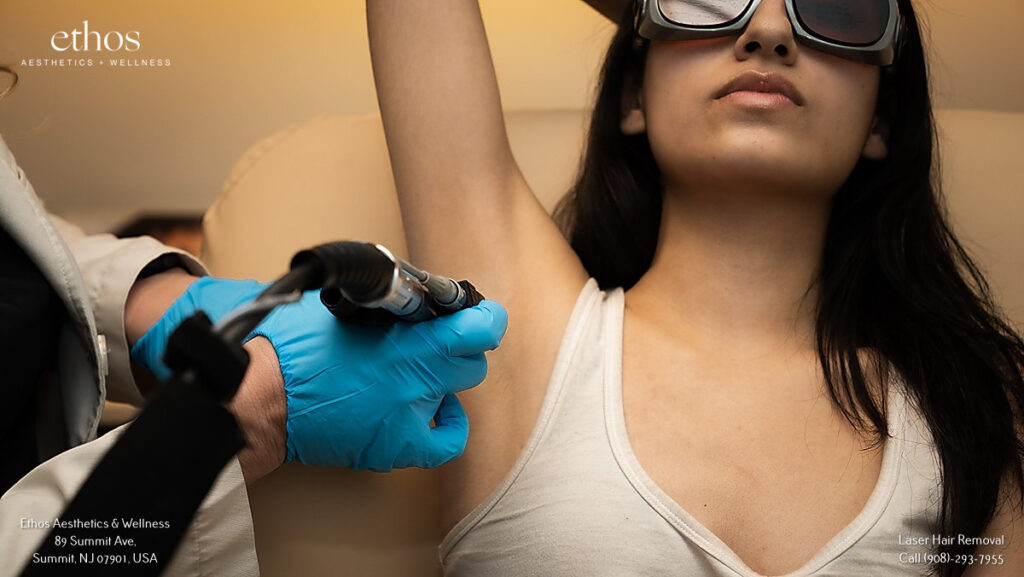Smooth Sailing to Success: The Crucial Pre-Laser Shaving Step
Smooth, stubble-free skin without the razor burn – that’s the dream when prepping for laser hair removal. But rushing to shave before your treatment can leave your skin irritated, inflamed, and unfit for lasers.
Shaving the right way and at the right time ensures your skin is ready to achieve the best results. Do it wrong, and you risk complications, pain, less effective treatments, and poor hair reduction.
So how do you shave correctly prior to laser sessions for clean, calm, and hairless skin? And why is shaving so important for laser hair removal anyway? What happens if you skip this step?
Why Shaving Before Lasers is Non-Negotiable
Before we dive into the details, let’s recap how laser hair removal works.
This popular hair removal method uses highly concentrated beams of laser light to target the pigment in hair follicles.
The light energy gets absorbed by the melanin in the follicles, which heats them up and damages their structures. This stops future hair growth because they can’t penetrate and zap what they can’t see.
Laser hair removal can remove hair from all parts of the body – legs, arms, underarms, bikini line, face, you name it.
Now, shaving before laser hair removal is crucial for several reasons:
Shaving Allows Lasers To Penetrate The Hair Follicle
One of the main reasons you need to shave before laser hair removal is it allows the laser light to penetrate the follicle better. Let’s take a closer look at why this matters:
- Lasers target the hair follicle: The goal of laser hair removal is to damage the hair follicle structure. So the laser energy needs to reach the follicle where the hair originates.
- Hair above the skin blocks the laser: When hair is left unshaved, it sits above the surface of the skin. This hair shaft will block some of the laser light from reaching the follicle below.
- Shaving removes the barrier: Removing hair above the skin eliminates this barrier. This allows the laser direct access to the follicle to inflict maximum damage.
It’s physics – shaving before laser removal allows optimal light penetration into the target. Leaving hairs unshaven means the laser has to waste energy getting past them before reaching the root. You want the full power directed at the follicle for best results.
More Hair Is Destroyed When Follicles Are Directly Targeted
Another benefit of shaving is that more hair can be destroyed per treatment. Here’s why:
- Only anagen follicles are treated: Laser hair removal only affects follicles in the active anagen (growth) phase. Follicles in resting or shed phases are essentially invisible to the laser.
- Shaving synchs cycles: Shaving resets the hair growth cycle, bringing more follicles into the active growth stage. This means more hairs are available targets.
- Direct damage is more destructive: With shaving, the laser can inflict direct damage on the follicle unimpeded. This has a better chance of destroying the follicle completely so it cannot produce new hairs.
Shaving before laser hair removal allows the laser to reach more hair follicles directly, leading to significantly greater hair reduction per treatment. Unshaved hairs can block the laser’s path, reducing its effectiveness.
So regular shaving prior to appointments enables the laser to eliminate exponentially more hairs compared to leaving them unshaved.
Shaving Prevents Skin From Overheating

Another advantage of removing hair before laser is it helps prevent skin from overheating. Here’s why this matters:
- Laser energy gets absorbed: Skin and hair absorb light energy from the laser. Too much heat risks burns.
- Dark hair absorbs more: Coarse dark hairs soak up more laser energy than paler fine hairs.
- Hair insulates heat: Unshaved hair acts like a wick retaining the heat against the skin. This can heat the underlying skin to dangerous levels.
- Removing hair stops insulation: Shaving eliminates the dead hair insulating the skin surface. This allows heat to dissipate rather than building up.
So shaving beforehand avoids excessive localized heating of the skin. This makes the process more comfortable and safer for your skin.
More Comfortable Treatments With Less Risk Of Ingrown Hairs
Shaving before laser hair removal also provides more comfortable treatments and less risk of ingrown hairs afterwards. How so?
- Stubble causes laser discomfort: Short coarse hairs absorb laser energy well. Leaving even stubble can cause irritation and pain.
- Smooth skin has no friction: Removing all hairs leaves skin ultra smooth. This eliminates irritation from hairs rubbing on clothes or the laser applicator head.
- Ingrown risks drop: Shaved hairs have tapered tips that can more easily exit follicles. This makes ingrown hairs less likely compared to treatments on unshaved hair.
- Numbing creams work better: Topical numbing creams penetrate shaved skin better to reduce pain during treatment.
So if you want a smooth comfortable laser experience with minimal ingrowns or razor bumps, shaving first is a must.
When to Shave – Getting the Timing Right
Shaving too soon or immediately before your laser appointment can make skin sensitive and prone to irritation. But leaving it too long will result in subpar hair removal.
Follow these timing tips to prep skin perfectly:
| Timing | Recommendation | Rationale |
| 1 Week Before | Not Ideal | Shaving a week before is too long as hair length will interfere with lasers. |
| 1-3 Days Before | Ideal | At least 1 to 3 days of regrowth is recommended for an effective treatment. This gives time for any shaving irritation to settle while leaving optimal stubble. |
| 24-48 Hours Before | Ideal for Brazilians and Slower-Growing Areas | and Slower-Growing Areas For Brazilians and slower-growing areas, shaving 2 to 3 days prior is recommended. |
| 1 Day Before | Ideal for Face and Faster Regrowth | For the face and faster regrowth areas, a closer shave 1 day before may work. |
| Immediately Before | Too Short | Shaving right before is too short for lasers to target the follicles underneath. It can also make skin sensitive and prone to irritation. |
Consider your individual hair growth rate and shave accordingly. When in doubt, consult your laser technician on the ideal timing.
If you miss the window, it’s better to shave the day before versus not at all. Just be prepared for more discomfort and avoid any irritating products.
How To Shave Properly Before Laser Hair Removal
Now that you know why shaving before laser matters, let’s look at some tips on how to prep skin correctly:
- Use a fresh sharp razor: Dull razors pull on hairs, causing ingrown risks. Use a new high-quality razor each time for a close smooth shave.
- Shave in the direction of growth: Go with the grain to get a close shave without irritation. Never shave against the direction hairs grow.
- Avoid irritation: Use a gentle natural moisturizing shave cream or oil. Soften hairs first in a warm shower. Pat dry – rubbing inflames skin.
- Moisturize after: Gently pat on aloe vera gel after to soothe and hydrate. Avoid products with harsh chemicals.
- Exfoliate between sessions: Use a sensitive skin scrub between laser sessions to prevent ingrown hairs. Avoid exfoliating for 48 hours pre- and post-treatment.
- No plucking/waxing: Remove hairs only by shaving. Tweezing or waxing can disturb follicles and reduce laser effectiveness.
Following these tips will ensure your skin is properly prepped for the most comfortable, effective laser hair removal process.
Getting Your Skin Laser Ready
How you prep and care for skin before and after shaving is equally vital. Here are pro tips to avoid irritation:
Before:
- Exfoliate 2 to 3 days before shaving to lift hairs and prevent ingrown. Avoid harsh scrubs.
- Stop using irritants like retinoids, benzoyl peroxide or salicylic acid a week prior. They make skin sensitive.
- Sterilize razors and thoroughly cleanse skin to prevent infection and acne after shaving.
- Softening hairs with warm water/steam allows a smoother, closer shave.
After:
- Immediately apply antiseptic like witch hazel followed by aloe vera gel to soothe skin.
- Avoid sun exposure after shaving as lasered skin is highly sensitive. Wear SPF 30+ sunscreen.
- Keep skin hydrated with gentle, fragrance-free moisturizers but avoid heavy occlusive creams before lasers.
- Watch for redness, bumps or rashes after shaving and treat with hydrocortisone if needed.
Take it easy on your skin around shaving for lasers. Exfoliate gently, sterilize properly, and avoid irritants to minimize sensitivity.
Are You Ready To Start Your Laser Hair Removal Journey?

And there you have it – the reasons why shaving is a mandatory part of successful laser hair removal results. Now that you understand why this prep step matters, you can move forward with treatments confidently.
When performed properly, laser hair removal can free you from annoying body hair maintenance for the long term. Just be sure to shave correctly before each session, and avoid plucking or waxing between treatments.
Ready to get started? Book a consultation with Ethos Spa today to discuss your treatment plan. Be sure to ask any questions you have about the process.
With some patience and shaving diligence, you’ll be on your way to silky smooth skin in no time. So say goodbye to razors and waxing strips, and hello to laser!







